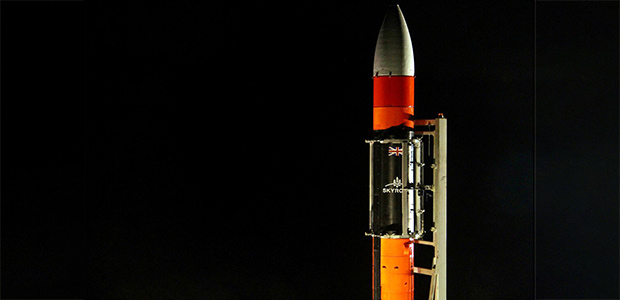
Where are they now? Skyrora
When we last spoke to Skyrora 18 months ago in our Jan/Feb 2024 edition, CEO and Co-Founder Volodymyr Levykin likened the company to being a “space taxi”. The vision was to disrupt the space industry by becoming the first private orbital launcher – designing, manufacturing, and deploying launch vehicles for satellites – all with sustainability in mind.
This time round we speak to Derek Harris, Head of Business Development, who has been with the company since day dot – more or less. So, let’s see what Skyrora has been up to since our last chat.
Getting up to speed
“The last 18 months have been a bit of a whirlwind for us,” says Harris. “The main project we’ve seen coming along is the work with our 3D printer.”
Harris is referring to Skyprint 2, the largest hybrid 3D printer of its kind in Europe. Developed by Skyrora, the printer combines both additive and subtractive manufacturing processes on the same platform – meaning it can print complex rocket parts more efficiently. The company has been advancing its 3D printing capability as part of a Horizon-funded consortium called Made 3D.
One of the major developments is Skyrora’s work on bi-metallic 3D printing, combining Inconel – the alloy already used in its engines – with copper. “We can lighten our engines, and the copper gives better heat resistance as well,” says Harris. “But this hasn’t been done, as far as I’m aware, anywhere yet ... this will be a world’s first.”
Spirit AeroSystems and second-life parts
Alongside in-house developments, Skyrora is also progressing through a contract with Spirit AeroSystems, testing structural parts for aerospace. These are not limited to new aircraft designs, but also focus on parts that are no longer manufactured – similar to automotive aftermarkets.
“This can help prolong the lives of actual vehicles,” Harris explains. “And it’s an interesting project to be involved in.” The idea is to support sustainability by keeping aircraft in service longer – reducing waste, extending service life, and easing supply chain constraints.
Materials R&D and ESA collaborations
Skyrora is also working with two other chemical compounds as part of European programmes, including ESA’s General Support Technology Programme (GSTP). These aim to identify new materials that are more efficient and better suited to extreme aerospace environments – but with an eye to broader applications.
“This has a huge jump forward in technology, not just for space. It can affect almost every other sector once the technology is tweaked.”
3D printing with Skyrora
Harris explains that in the beginning 3D printing was necessary to getting started.
“You couldn’t really hang your hat on production from other people because you’re then at the mercy of their schedule … being able to control and make that technology in-house has allowed us a level of comfort I think other launchers don’t have.”
The big boon for Skyrora is that it can use these capabilities to make it's engines lighter and cheaper and more sustainable: “Instead of having to chisel out metal channels and be wasteful, you're cutting that down by at least a third – in price and in quantity. I believe all space companies need to be looking at this going forward, especially rocket companies.”
A diversified revenue structure
Another way for the forward thinking spacetech company to diversify its offering is via its printing capabilities, especially with Skyprint 3 under consideration: “Ultimately, what I foresee could happen would be a conveyor belt of these machines making different parts. If we don’t have a huge manifest backlog or requirement, these can then be put out to rent for other industries,” said Harris.
This white-label model not only brings in revenue, but it also shares Skyrora’s sustainability and manufacturing learnings more widely. “Hopefully if you start to print for those other industries, they can have the same sort of changes and sustainability push that we get.”
The highs and lows of the last 18 months
Harris notes that a particular highlight for the company over the last 18 months is the progress of Skyrora’s engine programme: 17 engines built, and 42 hot fire tests completed. Nine of those engines are now fully qualified for flight.
“That is something that’s just amazing to see – all nine engines working together … it’s like being at Glastonbury with all the bass going through.”
But the journey hasn’t been without its challenges. Delays in regulatory approvals, unpredictable weather, and concerns about the fairness of industrial funding have all added friction, but the team’s perseverance is proving fruitful.
STEM education and outreach
On a personal note, Harris speaks about his passion for education. He’s keen to see launch activities embedded in the UK so that more apprenticeships, graduate roles, and outreach programmes can follow.
“If we can establish launch as a sector in the UK, then that allows companies to grow – which then allows the next generation to come in,” he says. “You could be building satellites. You could be building quantum encryption. This is what’s coming.”
Where to next?
Skyrora’s next 18 months could be shaped by licensing, shifting geopolitical pressures, and how far its 3D printing capabilities can stretch beyond the space sector.
While commercial launches remain at the heart of the business, Harris expects Skyrora’s flexibility to open up defence and infrastructure contracts as well.
“There will be technology we have that the UK Government will want to look at,” he says. “Imagine having one of those 3D printers keeping a Hercules aircraft going ... or printing a spare axle for a Defender.”
From small components to high-thrust mission-ready engines, Skyrora’s journey is certainly an exciting one and it remains rooted in its core values of education and sustainability and, I would add, resilience.
This article originally appeared in the July/August 2025 issue of Startups Magazine. _Click here to subscribe

